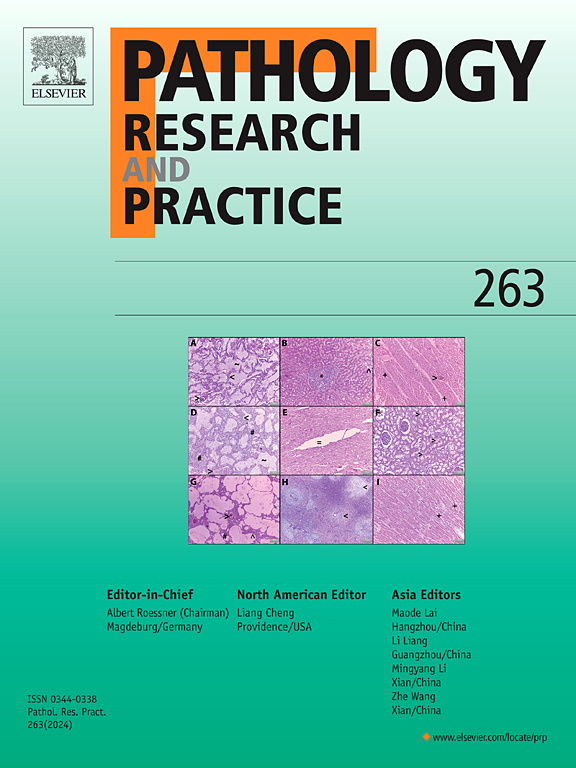LRPPRC通过HIF-1ꭤ/ vegf介导的血管生成促进结直肠癌的进展
IF 3.2
4区 医学
Q2 PATHOLOGY
引用次数: 0
摘要
背景:远处转移是结直肠癌(CRC)患者死亡的主要原因。血管生成在癌症的发展、侵袭和转移中起着至关重要的作用。然而,驱动血管生成的信号机制尚未完全阐明。本研究探讨了富含亮氨酸的五肽重复基序蛋白(LRPPRC)在结直肠癌转移中的作用。方法观察LRPPRC对结直肠癌细胞和小鼠异种移植瘤模型的影响。通过免疫组化(IHC)染色CRC组织芯片分析LRPPRC表达水平与临床病理特征的相关性。采用免疫印迹法、免疫荧光法、基于huvec的管形成法、共免疫沉淀法和侵袭法评估lrpprc诱导的增殖和血管生成。通过功能增益实验评估LRPPRC在细胞增殖和血管生成中的功能。结果slrpprc在结直肠癌组织中表达水平显著上调,且LRPPRC表达水平越高,结直肠癌患者预后越差,生存期越差。小鼠异种移植模型表明,过表达LRPPRC通过血管生成显著促进结直肠癌的发展。此外,LRPPRC诱导血管内皮生长因子(VEGF)表达水平,VEGF的恢复恢复了LRPPRC敲低引起的血管生成抑制。LRPPRC通过与CRC细胞中的缺氧诱导因子1- α (HIF-1α)相互作用促进其活化。结论LRPPRC通过激活HIF-1α/VEGF信号通路,有效促进结直肠癌的生长和血管生成。这些发现可能为结直肠癌的发展提供新的治疗靶点和潜在的预后生物标志物。本文章由计算机程序翻译,如有差异,请以英文原文为准。
LRPPRC promotes the progression of colorectal cancer via HIF-1ꭤ/VEGF-meditated angiogenesis
Background
Distant metastasis is the primary cause of mortality in patients with colorectal cancer (CRC). Angiogenesis plays a critical role in cancer development, invasion, and metastasis. However, the signaling mechanisms driving angiogenesis were not fully elucidated. This study investigated the role of leucine-rich pentatricopeptide repeat motif-containing protein (LRPPRC) in CRC metastasis.
Methods
The impact of LRPPRC was assessed in CRC cells and a mouse xenograft model. The correlation between LRPPRC expression level and clinicopathological features was analyzed through immunohistochemical (IHC) staining on CRC tissue microarrays. LRPPRC-induced proliferation and angiogenesis were evaluated using immunoblotting, immunofluorescence, HUVEC-based tube formation, co-immunoprecipitation, and invasion assays. Gain-of-function experiments were performed to assess the function of LRPPRC in cell proliferation and angiogenesis.
Results
LRPPRC expression level was significantly upregulated in CRC tissues, and a higher LRPPRC expression level was associated with a progressive prognosis and poorer survival in CRC patients. The mouse xenograft model indicated that overexpression of LRPPRC significantly promoted CRC development via angiogenesis. Additionally, LRPPRC induced vascular endothelial growth factor (VEGF) expression level, and the restoration of VEGF rescued the angiogenesis suppression caused by LRPPRC knockdown. LRPPRC promoted the activation of hypoxia-inducible factor 1-alpha (HIF-1α) by interacting with it in CRC cells.
Conclusion
It was revealed that LRPPRC effectively promoted CRC growth and angiogenesis by activation of the HIF-1α/VEGF signaling pathway. The findings may provide a new treatment target and a potential prognostic biomarker for CRC development.
求助全文
通过发布文献求助,成功后即可免费获取论文全文。
去求助
来源期刊
CiteScore
5.00
自引率
3.60%
发文量
405
审稿时长
24 days
期刊介绍:
Pathology, Research and Practice provides accessible coverage of the most recent developments across the entire field of pathology: Reviews focus on recent progress in pathology, while Comments look at interesting current problems and at hypotheses for future developments in pathology. Original Papers present novel findings on all aspects of general, anatomic and molecular pathology. Rapid Communications inform readers on preliminary findings that may be relevant for further studies and need to be communicated quickly. Teaching Cases look at new aspects or special diagnostic problems of diseases and at case reports relevant for the pathologist''s practice.

 求助内容:
求助内容: 应助结果提醒方式:
应助结果提醒方式:


